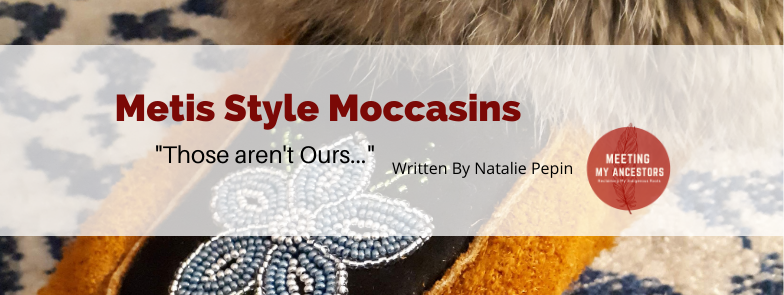What are Metis Moccasins? It Depends…
I am blessed to have a grandmother who my father likes to remind me that I am very much like…which I take as a compliment. She is strong (he might say stubborn) and raised children (4 boys) on her own in a time when this would have been even more difficult than it is today. My grandmother has worked to connect our family to our ancestors through her focus on geneology. She has been involved in the creation of family history records for our nation, and for my family. Her interest in history and passion for our culture are traits I share.
Having an elder in my family who knows our culture is a blessing. I remember her many years ago telling me about our moccasins. “Those aren’t our moccasins” she said, referring to pucker toe moccasins. “Ours have pointed toes.” And…of course…she’s right. Traditional Metis style moccasins were most commonly split toe (also called pointed toe) moccasins. Now, in a more nuanced way, our culture has grown from the convergence of several others. It is from those roots that our beautiful culture has grown. Because of these roots which can be traced back to several nations, some of our clothing can be influenced more from one nation or another. It is also true that our culture has changed in small ways over time.
Our beautiful culture is alive today thanks to the dedication of our ancestors and elders. Because ours is a live culture, it means that aspects of our culture are not necessarily static. What was true two hundred years ago, may not still be true of our culture today. For example, although I choose to, not all Metis live in cabins in the woods and tan hides. It’s not quite as prominent in modern Metis identity. This changing nature of culture is what allows ethnogenesis (the creation and birth of cultures), but it is also what allows cultures to adapt and remain relevant in a changing world.
Our traditional moccasin style is indeed the pointed toe style that can be seen in these which were auctioned through WorthPoint.

https://www.worthpoint.com/worthopedia/c1890-cree-metis-indian-porcupine-139278368
And these which can be seen on the Manitoba Museum website at https://manitobamuseum.ca/main/collections-research/collections-database/collection-detail/?id=63&cat=hbc (worth the quick click). This pair are “Slipper-style, pointed-toe moccasins constructed from smoke-tanned moose hide. The seams of the moccasins were hand-sewn with sinew thread made from finely split and dried animal tendons.” as described by FurTrade Stories at http://furtradestories.ca/details_content-id-278_cat-id-3_sub-cat-id-1.html
In modern times (and also from time to time throughout history), however, Metis have also adopted the rounded, pucker toe moccasins. These are similar in shape to those that are sold through companies like Manitobah Mukluks and that most people think of when they imagine moccasins.
You can see a pair of moccasins in this style on the Gabriel Dumont Institute website here http://www.metismuseum.ca/resource.php/06653
Both of these styles of moccasins can, in our modern day, be truthfully called Metis style. You will find many Metis artisans making and selling both styles, including Lisa Shepherd who’s website and heirloom collection can be viewed here…
https://www.lisashepherd.ca/heirloom-pieces.html
Both of these styles of moccasins share certain features. They are both soft soled moccasins that use brain tanned hide (typically moose or elk), and more recently split suede (most often cattle hide). Commercial suede is much cheaper to produce than brain tan, and is much more readily available. However, brain tanned moose is still my favourite hide for moccasins that are easy to make and are long lasting.
Another similarity is the beaded or silk embroidered vamps (or tops) of the moccasins. Although both styles have decorated vamps, the vamps of split toe moccasins are considerably smaller in size.
Pucker toe moccasins can have high, turned up, wrap around ankles, but most commonly are trimmed with fur as indoor slipper style moccasins. Split toe moccasins are seen in both indoor fur trimmed style and as wrap arounds also.
Regardless of the style of moccasins being worn by Metis people today or in our culture’s past, the most recognizable feature is of course…our beautiful flower beadwork.
Metis style floral beadwork
Adorning items with flower beadwork is a recognizable Metis trait. With colourful flowers, berries, leaves and vines, beadwork patterns reflected the close relationship that our nation has developed with the land that supports us and that we in turn steward and protect.
Beyond beadwork, silk embroidery and quillwork were also seen on moccasins and continue to be art forms practiced within our nation.
Changing traditions
As with all things in our nation, what we consider traditional depends on the time, and often the location we are discussing. With such a large landscape as a homeland, and with kinship ties to several cultures, it’s no wonder such variety in designs and styles can be seen in our traditional clothing. As a living culture, which adapts and evolves over time, it’s is even more understandable that we should see changes and evolutions in clothing and traditions.
So…What did (or do) Metis people wear?….It depends.
In honour of our past and present, you can learn how to make either pucker toe moccasins or the more traditional split toe moccasins in our culture outreach classes here at Meeting My Ancestors.
Learn how to make either style here…

